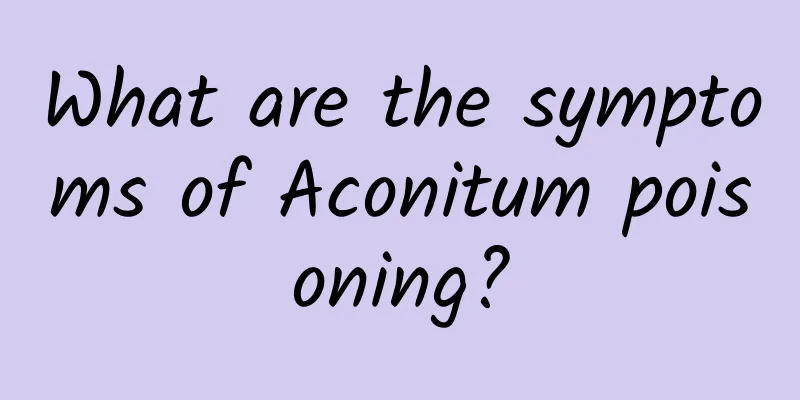What are the symptoms of Aconitum poisoning?

|
Generally speaking, Aconitum needs to be decocted for more than half an hour first, so that its toxicity can be reduced. Otherwise, it is easy to cause poisoning. Aconitum poisoning usually occurs within 3 hours after taking the medicine. The body will experience sensitivity in the limbs, dizziness, nausea, low blood pressure and other symptoms. You need to go to the hospital for treatment in time. What are the initial symptoms of Aconitum poisoning? ① Excitement of the vagus nerve, manifested as sweating, salivation, nausea, vomiting, abdominal pain, diarrhea, bradycardia, decreased blood pressure, pupil constriction, incontinence and pulmonary edema; ②Damage to peripheral nerves, clinical manifestations include numbness and tightness of the mouth, tongue and whole body, decreased or hypersensitive pain and temperature sensation, and motor dysfunction in severe cases. ③ By stimulating the vagus nerve, the autonomy of the sinoatrial node is reduced, and the autonomy of the ectopic pacemaker is increased, causing various arrhythmias. ④ Direct myocardial poisoning. These damages mostly occur within the first 24 hours after taking the drug. According to the history of medication and the clinical symptoms and signs listed in Table 1, the diagnosis is usually not difficult. There is no difference between groups a and b in terms of gender, age, symptoms and signs caused by vagus nerve excitement and peripheral nerve damage. The comparison between groups a and b shows that cardiac damage is an important and significant feature in the diagnosis and treatment of aconitine poisoning, and it is also the most important and most common risk factor. Will Aconitum poisoning cause fever? Generally not. If the symptoms are serious, it is better to go to the hospital. Raw Aconitum carmichaelii is a very common Chinese medicine. It is named Aconitum because its appearance is similar to that of a crow's head. The artificially cultivated variety is called Chuanwutou, and the wild variety is called Caowutou. The lateral roots of Chuanwutou are also known as Aconite. These aconite drugs all contain aconite, which is extremely toxic to humans. Ordinary people only need to take 3 to 4 mg to experience panic, heart palpitations, arrhythmia, and even cardiac arrest. Aconitum kusnezoffii is extremely toxic when used raw. After processing, the aconitine will be hydrolyzed and the toxicity will be reduced. The longer the boiling time, the lower the toxicity. If it is boiled for more than 4 hours, it will be almost non-toxic. Therefore, Aconitum carmichaelii is generally used as a processed product and must be decocted first, and the dosage should not be too much. How to eat Aconitum kusnezoffii correctly? Compared with oral administration, external use of Aconitum is relatively safe. When there is no break in the skin, it can be directly crushed and applied to make a plaster or medicinal wine for drinking and external use. It can treat cold pain in the waist and knees, periarthritis of the shoulder, bone hyperplasia, facial nerve paralysis, trigeminal neuralgia, and swelling and pain caused by blood stasis. The juice of Aconitum kusnezoffii ground into wine and applied externally can also treat lymphadenitis and lymph tuberculosis. Although Aconitum kusnezoffii has medicinal value, it is easy to cause aconitine poisoning when it is used because it is difficult to grasp the toxic dose and therapeutic dose. When decocting Chinese medicine at home, if you experience symptoms of Aconitum poisoning such as numbness of the mouth, lips, or tongue, itching of the face and skin, a crawling sensation of ants, nausea, and panic, you should go to the hospital immediately for treatment. While going to the hospital for treatment, you can take large amounts of licorice water or mung bean soup to detoxify. |
<<: What is the difference between Chuanwu and Caowu?
>>: What are the taboos of eating Aconitum carmichaelii?
Recommend
Belly button protrusion in late pregnancy
It is normal to have a protruding belly button in...
The great way is simple VS the great ways are different, where does physical organic chemistry lead to?
Von Neumann once said: "Four parameters can ...
What are the effects of black tongkat ali
Tongkat Ali actually has very high medicinal valu...
The efficacy and function of yellow alfalfa
What are the functions of yellow clover? As a tra...
The efficacy and function of walnut leaves
In today's society, health preservation seems...
What are the prescriptions for snake venom?
The chance of encountering snakes in cities is re...
Goggles for birds? Scientists too full?
In nature, no birds wear goggles. They do not nee...
World Beauty Day丨The most cost-effective "beauty" method, you may have been doing it wrong
November 7th of each year is World Beauty Day, wh...
Dogs, don’t stay idle at home, take online classes | Nature Trumpet
Welcome to the 58th issue of the Nature Trumpet c...
The efficacy and function of Aconitum kusnezoffii
Aconitum carmichaelii is a traditional Chinese me...
What are the taboos of Tianma Shouwu
Tianma Shouwu is a medicine, which is generally a...
The genetic bug hidden in the bloodline of European royal families is actually regarded as a symbol of nobility
A small injury will cause bleeding Replacing a to...
The efficacy, effects and contraindications of white silkworm
The functions and effects of Bombyx Batryticatus:...
What is the medicinal value of black wolfberry?
Black wolfberry can also be considered a type of ...
The efficacy and function of longan root [picture]
Traditional Chinese medicine is a Chinese traditi...









